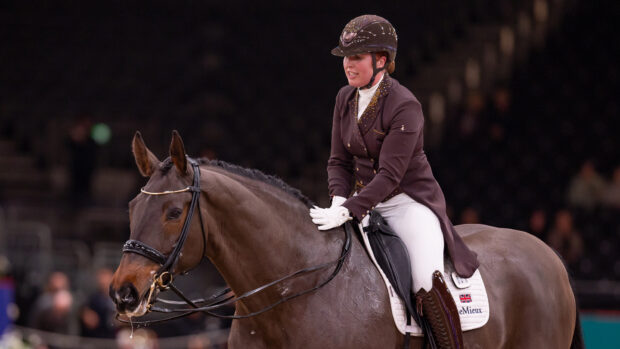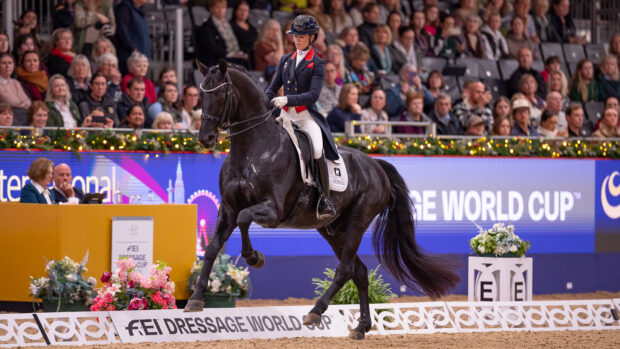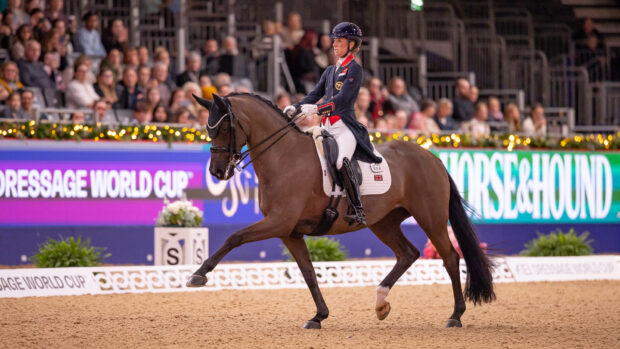It is amazing how much John and Charlotte Lassetter have in common. Both were brought up by medical professionals, both enjoy acting and both spent time at the Spanish Riding School in Vienna, not to mention having the same sense of humour and fun.
John’s talent to impersonate was inspired by two ladies, Guinea and Mimi, from Bournemouth, who adopted him as a baby.Guinea, one of the first women doctors to specialise in radiotherapy, came from an extremely wealthy background – the family owned a Australian business similar to Harrods – while Mimi, a cancer nurse, came from a down-to-earth corner shop.
“One minute, I would sound toffee-nosed, then I would visit Mimi’s parents,” says John, as he impersonates a rather different accent.
John started riding aged four at a local riding school, but, after a bad fall, took up ice-skating “seriously”, taught by a former world champion. He returned to the saddle with the New Forest Pony Club branch, which led to him winning a point-to-point and county showing classes, as well as hunting with the New Forest Buckhounds.
John attended Durlston Court prep school – “the same as Tony Hancock” – where the headmaster nurtured his interest in amateur dramatics.However, John’stime at boarding school was not as happy: “I was like a square peg in a round hole. “Fortunately, the housemaster let me ride his hunter and I schooled his daughter’s pony, but I left early and had a private tutor.”
John was offered a place at drama school in Bristol, but took the equestrian route instead.”I travelled to lots of different trainers,” he says, rattling off a list of famous names, including Robert Hall, Mollie Sivewright, who lent him a horse, and Egon von Neirndorff.
From there, he went to the newly-established Crabbett Park Equestrian Centre in Sussex, where he became a senior instructor.”I stayed for three years and this was the springboard for Vienna. One of my former teachers sent letters of recommendationand I got an interview. They were going to take two pupils for the first time in 15 years. Then there was a problem with the ministry and they sent a letter to cancel my placement, but I never received it.”
John became the Spanish Riding School’s one and only pupil in 1969. After a year, he was due to return to Crabbett Park, but instead went to the Cadre Noir in Saumur for a week’s course. He was invited to stay and the fees were waived.He returned to run Porlock Vale Riding School with his first wife, Dale, bringing back five Lipizzaners. After a few years, the centre’s owner went bankrupt and the Lassetters tried and failed to set up their own centre. Desperate, John contacted the Duke and Duchess of Richmond, who invited him to set up at their home, Goodwood Park, in Sussex, where John has been for the past 21 years.
John’s second wife, known as “Char”, does not remember the first time she sat on a horse: “I rode at my first gymkhana when I was three years old and in my first dressage test when I was six. I remember that I couldn’t get my pony to canter without my whip and shall never forget the judge’s comment: “Test would be improved by riding within the boards”!”
Char’s mother, a Pony Club examiner, encouraged her children to school their ponies correctly.Char, now 39, recalls: “Although I was interested in eventing, my pony and I were “chicken” when it came to jumping, so we did a lot of dressage and working pony classes instead.”
Her father, a non-horsey doctor, encouraged her to do something other than horses.”I did the shortest course I could find – Cordon Bleu cookery,” she says. The result was that she ran a pub for a year, taught mentally handicapped teenagers to ride and cook and set upher own catering business.Char was offered a job with the late classical dressage maestro, Nuno Oliviera, but she turned it down and ended up working for Hans Riegler, who started as an apprentice at the Spanish Riding School on the same day that Johnstarted his scholarship there.
When Char returned to England, she worked for John and Dale for nearly a year. Next came a spell in America on a 7,000-cattle ranch, where she broke in Quarter Horses: “I got laughed at, as I insisted on using anEnglish saddle, even when rounding up.”
Meanwhile, back in England, John and Dale’s marriage had broken down. “Dale left Goodwood, but I didn’t want to go, so I phoned the Duchess and begged to stay,” says John.Char returned there and theystarted to build up the centre, putting on their first pantomime, Snow White and the Seven Dwarfs, in 1986. John, who has held demonstrations on a regular basis since his days in Vienna, says: “They didn’t make anybody laugh and the pantos came as a natural progression. I have always loved showbiz, particularly comedy.”A tour of Britain followed and, as word spread, invitations came from shows in Holland, Germany, Canada and America.
This is John’s way of making the sport more accessible:”The dressage world needs better PR down the scale. The sport needs personalities, to pull people in to watch competitions and build up media coverage – bringing our sport to the man in the street.”
The 11-year-old Danish-bred Golden Garibaldihas now lured John back into the competition arena after a three-year absence.
“I think it’s a realistic dream – I’m not likely to go to an Olympic Games. I was qualified for Atlanta in 1996, but the horse’s wind went. I’ve competed at top international level, got a few young riders on to the British team and now Char has come to the fore.”
Char and John took out a loan to buy the talented Dutch-bred Excellance and Char has made the international squad with him.
It has not been easy, though. He pulled a suspensory ligament galloping in the field with the Shetland pony bought, ironically, to keep him calm.
Char is equally realistic when it comes to her plans: “You can’t have hard and fast ambitions with horses. They tend to do horrible things to themselves [she lost a prix st georges horse to colic].
“What the future holds for the business is currently on the Lassetters’ minds. The set-up is far from ideal since they moved to the former dairy, now Molcombe Stud, from the stables by Goodwood House. The indoor school is near the main house, which either means a 10-15min hack or boxing the horses there, and there are problems with the surface of the outdoor arena.However, John says: “The support from the Duke and Duchess has been superb.”
And this is no exaggeration, as they recall how the Richmonds brought picnic suppers to the horsebox they lived in for six months after the Duke and Duchess’s son moved into Goodwood House and the stables were needed by the Jockey Club.
Whatever the current problems, Char, who can usually be found mucking out at 7am, considers herself lucky and wouldn’t have things any other way: “You can’t be work-shy in this business, not even if you have a lot of money. Money brings other problems, in some ways it makes things more difficult and you have to be even more dedicated, as you have more options.”
Her concern is that there isn’t much time for anything else but the horses: “Time for people and each other. That’s what really matters.”


